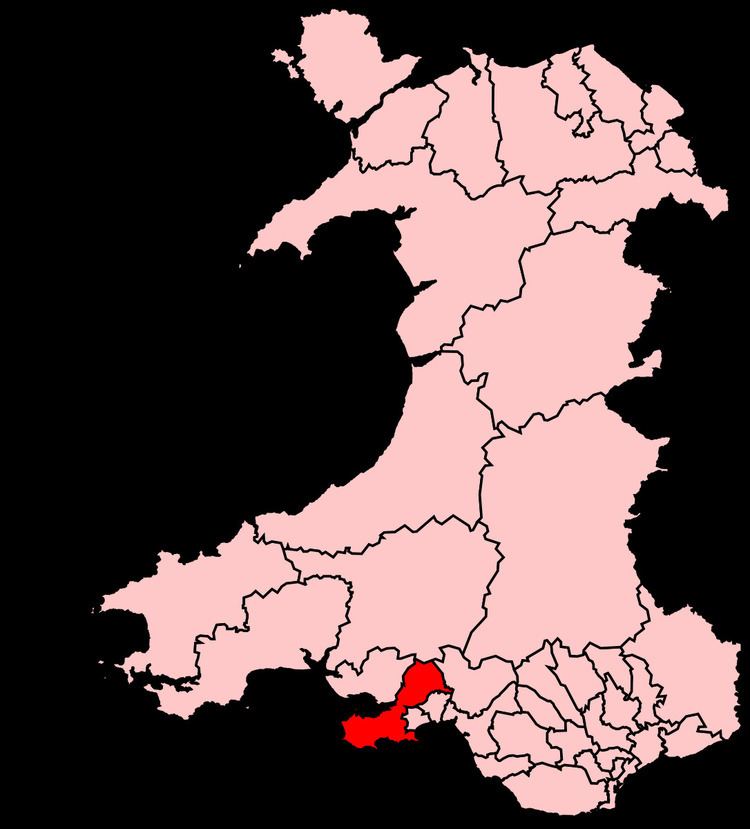Preserved county West Glamorgan Created 1885 European Parliament constituency Wales Number of members 1 Welsh assembly South Wales West | Electorate 62,389 (December 2010) Created from Glamorganshire Member of parliament Byron Davies Replaced by Glamorganshire | |
 | ||
Major settlements Mumbles, Clydach, Swansea, Pontarddulais, Penllergaer | ||
Gower (Welsh: Gŵyr) is represented in the House of Commons of the Parliament of the United Kingdom by one member of parliament (MP). Byron Davies, Conservative, is the MP after winning by the narrowest margin nationwide — 27 votes — in the 2015 UK General Election.
Contents
Overview
The constituency was created in 1885 and has had relatively widely varied boundaries. Before 2015 it had elected Labour MPs since 1906, sharing the longest single-party representation with Normanton and Makerfield. It holds approximately a third of the electorate of the city and county of Swansea, the rest of which is Swansea West and Swansea East.
Boundaries
1885-1918: The Municipal Borough of Swansea, and the Sessional Divisions of Gower, Pontardawe, and Swansea.
1918-1950: The Urban District of Oystermouth, and the Rural Districts of Gower and Swansea.
1950-1983: The Urban District of Llwchwr, and the Rural Districts of Gower and Pontardawe.
1983-2010: The City of Swansea wards of Bishopston, Fairwood, Gower, Newton, Oystermouth, Penclawdd, Pennard, and West Cross, and the Borough of Lliw Valley wards of Clydach, Dulais East, Gorseinon Central, Gorseinon East, Gowerton East, Gowerton West, Graigfelin, Kingsbridge, Llangyfelach, Lower Loughor, Mawr, Penllergaer, Penyrheol, Pontardulais, Tal-y-bont, Upper Loughor, and Vardre.
2010-present: The Swansea County electoral divisions of Bishopston, Clydach, Fairwood, Gorseinon, Gower, Gowerton, Kingsbridge, Llangyfelach, Lower Loughor, Mawr, Newton, Oystermouth, Penclawdd, Penllergaer, Pennard, Penyrheol, Pontardulais, Upper Loughor, and West Cross.
The constituency encompasses most of the old Lordship of Gower (less the city of Swansea) and covers the inner Gower Peninsula and outer Gower areas including Clydach, Gowerton, Gorseinon, Felindre and Garnswllt.
Liberals and Labour 1885-1918
The first years, seeing more heavy industrial make-up than today, represented a struggle between the Liberals and those who favoured direct labour representation. Although its new electors in 1885 were predominantly the miners and tinplaters of the Swansea Valley, the new MP was Frank Ash Yeo, a local colliery owner and clearly an upper-class figure. In 1885 he comfortably defeated Henry Nathaniel Miers of Ynyspenllwch in the Swansea Valley, a coal owner, tinplate manufacturer and landowner.
On Yeo's death in 1888, representatives of the trade unions in the constituency overturned the Liberal association's choice of Sir Horace Davey and ensured the selection of David Randell as candidate. Randell was a Methodist solicitor who specialised in trade union litigation and his victory, albeit with a reduced majority over John Dillwyn Llewellyn, formed the basis of later claims that Gower was a 'labour' seat.
2015 General Election
The defeat of Labour's 2015 candidate, Liz Evans by Byron Davies, in the 2015 General Election, by 27 votes, less than 0.1% of votes cast, was the narrowest victory across the whole country, making it the most marginal Conservative seat. Subsequently, Davies' victory brought 105 consecutive years of Labour representation to an end.
Elections in the 1910s
General Election 1914/15:
A General Election was required to take place before the end of 1915. The political parties had been making preparations for an election to take place and by the July 1914, the following candidates had been selected;
